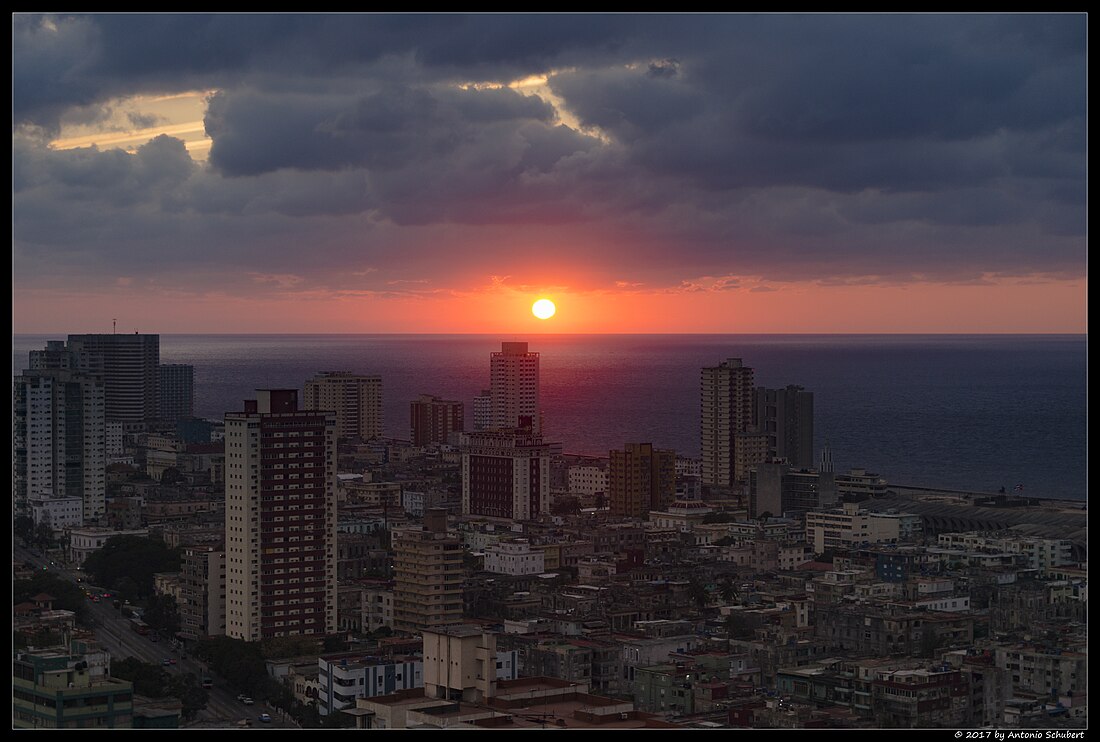Top Qs
Timeline
Chat
Perspective
Vedado
Urban neighborhood in the city of Havana, Cuba From Wikipedia, the free encyclopedia
Remove ads
Vedado (Spanish: El Vedado, Spanish pronunciation: [el βeˈðaðo]) is a central business district and urban neighborhood in the city of Havana, Cuba. Bordered on the east by Calzada de Infanta and Central Havana, and on the west by the Alemendares River and Miramar / Playa district, Vedado is a more modern part of the city than the areas to the east, developed in the first half of the 20th century, during the Republic period. In 2016 it was described by one commentator as the city's "most affluent" section.[1] The main street running east to west is Calle 23, also known as "La Rampa". The northern edge of the district is the waterfront seawall known as the Malecón, a famous and popular place for social gatherings in the city. The area popularly referred to as 'Vedado' consists of the wards (consejos populares) of Vedado, Rampa, Vedado-Malecón and Carmelo, all in the municipality of Plaza de la Revolución.
This article needs additional citations for verification. (November 2010) |

Remove ads
History
El Vedado was since the 16th century a part of the country where building was prohibited for military reasons. This changed in 1859 with the division of a piece of land in what would later be called el Carmelo. The land was divided with a tartan grid of 100 meter for the blocks and 16 meter for the streets. The main streets were 25 meters wide to make them suitable for a tram.
Soon followed other urban areas: el Vedado in 1860 and Medina in 1883. And at the start of the First Republic the once forbidden land was parcelled in full. Línea street was intended to build the tram track. The Avenidas Paseo, Presidentes (calle G) and 23 where among the other important streets.
The first buildings in this area were mainly bourgeois villas. In the thirties there was a first period of prosperity in which, among others, the López Serrano building and the hotel Nacional were built.
During the construction boom of the 1950s, dozens of tall apartment buildings were constructed. A famous building from that period is the Havana Hilton hotel, at that time the tallest hotel in Latin America.[2]
Remove ads
Notable sites
Among the notable sites in Vedado are the hotels: Hotel Nacional de Cuba (National Hotel), the Havana Libre (former Hilton), Melia Cohiba Hotel and Hotel Riviera.
In addition:
- Colon Cemetery
- FOCSA Building, tallest building in Cuba at 121 m
- Edificio del Seguro Médico, Havana
- López Serrano Building, first skyscraper in Cuba
- Radiocentro CMQ Building
- Coppelia (ice cream parlor)[3]
- Embassy of the United States, Havana
- José Martí Anti-Imperialist Plaza
- Jewish religious centers include the Gran Sinagoga Bet Shalom and the Centro Hebreo Sefaradi
- John Lennon Park, named for the statue of Lennon located there
- Monument to the Victims of the USS Maine
- University of Havana
- National broadcast center for Cuban television.
- Cementerio Chino (The Chinese Cemetery)[4]
Nearby neighborhoods include:
- To the east: Central Havana
- To the west: Miramar
Remove ads
Economy
Aero Caribbean has its headquarters in Vedado.[5]
The Venezuelan airline Conviasa has an office in the IACC Building in Vedado.[6]
Government and infrastructure
Instituto de Aeronáutica Civil de Cuba, Cuba's civil aviation authority, has its headquarters in Vedado.[7]
Culture
Gay scene
23rd Street in Vedado is also the centerpoint of the city's gay scene in a country which now grants many rights to LGBT citizens. At night, 23rd St. is reminiscent of a gay district between the Cinema Yara and Coppelia ice cream parlor, and the foot of 23rd at the Malecón, with numerous gay entertainment options nearby such as the Bim Bom outdoor bar and the Las Vegas nightclub. Many of the casas particulares target LGBT clients as customers.[8]
Remove ads
See also
References
Bibliography
External links
Wikiwand - on
Seamless Wikipedia browsing. On steroids.
Remove ads








